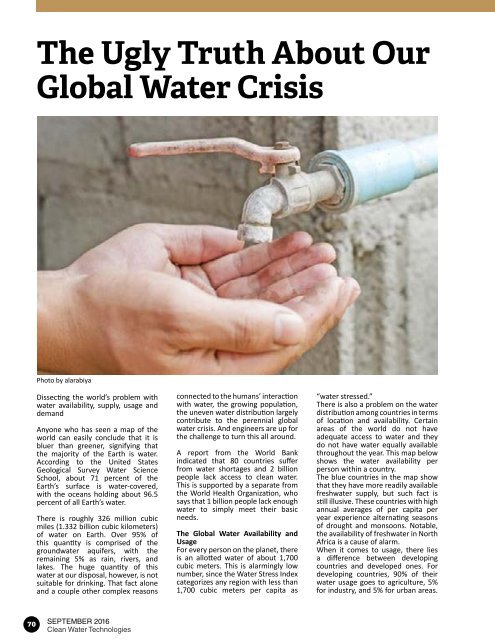GineersNow Engineering Magazine September 2016 Issue No 007
GineersNow Engineering Magazine September 2016 Issue No 007 Veolia Water Technologies: Sustainable water champion. Exclusive: Water for people, Cranfield University, Imagine H2O, WaterAid, Aviscus. Special Feature Stories: Desalination, Nanofiltration, Ultrafiltration, Reverse Osmosis, Water Treatment, Pipes, Pumps, HVACR, Oil & Gas, Construction, Heavy Equipment, Machinery, Tools, Civil Engineering, Mechanical, Electrical, Plumbing, MEP, Water, Wastewater, Renewables, Energy, Petroleum. Country Focus: Brazil, United States, UAE, Saudi Arabia, Qatar, Bahrain, Kuwait, Oman, United Kingdom, Singapore, Hong Kong, Philippines, Malaysia, Indonesia, India, Australia More engineering stories at https://www.gineersnow.com/topics/magazines
GineersNow Engineering Magazine September 2016 Issue No 007
Veolia Water Technologies: Sustainable water champion.
Exclusive: Water for people, Cranfield University, Imagine H2O, WaterAid, Aviscus.
Special Feature Stories: Desalination, Nanofiltration, Ultrafiltration, Reverse Osmosis, Water Treatment, Pipes, Pumps, HVACR, Oil & Gas, Construction, Heavy Equipment, Machinery, Tools, Civil Engineering, Mechanical, Electrical, Plumbing, MEP, Water, Wastewater, Renewables, Energy, Petroleum.
Country Focus: Brazil, United States, UAE, Saudi Arabia, Qatar, Bahrain, Kuwait, Oman, United Kingdom, Singapore, Hong Kong, Philippines, Malaysia, Indonesia, India, Australia
More engineering stories at https://www.gineersnow.com/topics/magazines
You also want an ePaper? Increase the reach of your titles
YUMPU automatically turns print PDFs into web optimized ePapers that Google loves.
The Ugly Truth About Our<br />
Global Water Crisis<br />
Photo by alarabiya<br />
Dissecting the world’s problem with<br />
water availability, supply, usage and<br />
demand<br />
Anyone who has seen a map of the<br />
world can easily conclude that it is<br />
bluer than greener, signifying that<br />
the majority of the Earth is water.<br />
According to the United States<br />
Geological Survey Water Science<br />
School, about 71 percent of the<br />
Earth’s surface is water-covered,<br />
with the oceans holding about 96.5<br />
percent of all Earth’s water.<br />
There is roughly 326 million cubic<br />
miles (1.332 billion cubic kilometers)<br />
of water on Earth. Over 95% of<br />
this quantity is comprised of the<br />
groundwater aquifers, with the<br />
remaining 5% as rain, rivers, and<br />
lakes. The huge quantity of this<br />
water at our disposal, however, is not<br />
suitable for drinking. That fact alone<br />
and a couple other complex reasons<br />
connected to the humans’ interaction<br />
with water, the growing population,<br />
the uneven water distribution largely<br />
contribute to the perennial global<br />
water crisis. And engineers are up for<br />
the challenge to turn this all around.<br />
A report from the World Bank<br />
indicated that 80 countries suffer<br />
from water shortages and 2 billion<br />
people lack access to clean water.<br />
This is supported by a separate from<br />
the World Health Organization, who<br />
says that 1 billion people lack enough<br />
water to simply meet their basic<br />
needs.<br />
The Global Water Availability and<br />
Usage<br />
For every person on the planet, there<br />
is an allotted water of about 1,700<br />
cubic meters. This is alarmingly low<br />
number, since the Water Stress Index<br />
categorizes any region with less than<br />
1,700 cubic meters per capita as<br />
“water stressed.”<br />
There is also a problem on the water<br />
distribution among countries in terms<br />
of location and availability. Certain<br />
areas of the world do not have<br />
adequate access to water and they<br />
do not have water equally available<br />
throughout the year. This map below<br />
shows the water availability per<br />
person within a country.<br />
The blue countries in the map show<br />
that they have more readily available<br />
freshwater supply, but such fact is<br />
still illusive. These countries with high<br />
annual averages of per capita per<br />
year experience alternating seasons<br />
of drought and monsoons. <strong>No</strong>table,<br />
the availability of freshwater in <strong>No</strong>rth<br />
Africa is a cause of alarm.<br />
When it comes to usage, there lies<br />
a difference between developing<br />
countries and developed ones. For<br />
developing countries, 90% of their<br />
water usage goes to agriculture, 5%<br />
for industry, and 5% for urban areas.<br />
70<br />
SEPTEMBER <strong>2016</strong><br />
Clean Water Technologies


















